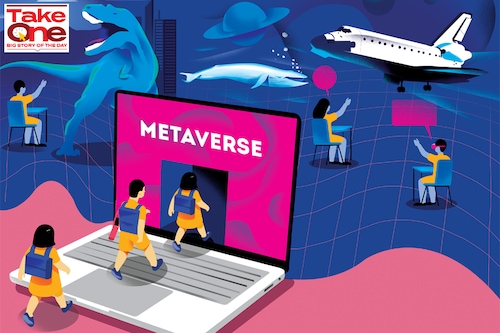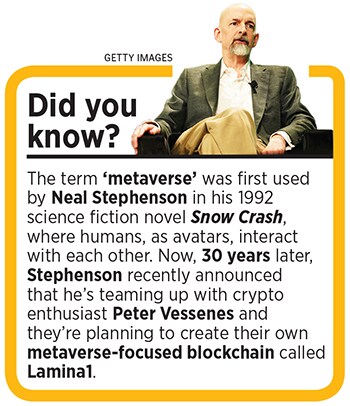What will learning in the metaverse look like?
Online learning just became mainstream, and now a handful of startups have started reimagining the future of education once again in India by working to integrate the metaverse into everyday learning


Imagine a classroom full of students where the history teacher is taking a lecture on the Harappa civilisation, the earliest known urban culture in the Indian subcontinent. Rather than reading the chapter from a book, the teacher takes the students to Harappa in Punjab, followed by Mohenjo-daro near the Indus river in the Sindh region. A chronological sequence of events is projected in front of the students and the students go around the sites, discover, ask questions, and learn.
This is what the future of education will look like in the metaverse, a virtual recreation of the real world. Users and developers can customise it in their own way, building anything from a metaverse school to virtual sports arenas.
Students and teachers can meet up in the digital space through virtual reality headsets irrespective of their real-life location. Then come the visual possibilities of a metaverse school. The teacher can talk about discoveries and show them to students in an immersive 3D environment at the same time. Educators can build virtual landscapes based on their lesson plans. Using virtual reality in schools can add value to traditional education models, whereby children can visit places from the past or conduct dangerous experiments in a safe virtual environment. For example, there can be simulations to teach students physics concepts, or a role-playing simulation of historic events. The actual communication between the teacher and the student during these lessons, however, happens in the real world.
Metaverse became a buzzword ever since Mark Zuckerberg rebranded Facebook to Meta in October 2021. Called the future of the internet by many, the metaverse can be accessed through virtual reality (VR) and augmented reality (AR) headsets and with phones, consoles, and linked gadgets. A white paper produced for Meta in May by the independent economic consultancy Analysis Group estimated the metaverse economy could be worth more than $3 trillion globally in a decade.

Meta also invested $150-million through Meta Immersive Learning to help increase access to learning through technology. The idea of using the metaverse to impart education may seem futuristic, but some Indian startups have already started exploring the possibilities. Bengaluru-based online-only school 21K School recently announced the integration of Web3 technology to help encourage students to be more creative. The school will introduce metaverse and blockchain technologies, like non-fungible tokens (NFTs), as ways to help students learn and create.
Backed by entrepreneur Ronnie Screwvala, the school currently has 6,000 students from 54 countries and provides the K-12 [kindergarten to class 12] education model. “There was a time when 2D content worked, but right now 3D immersive and practical content is required. Teaching is also two-sided, in which the students and teacher both participate. Metaverse is a move towards improvising a personalised and engaging experience for the kids," says Santosh Kumar, co-founder and CEO of 21K School, which was founded in June 2020. The product is in beta testing, and will be available for students by December this year.
Another startup, Invact Metaversity, grabbed eyeballs recently, even before it launched its first batch. In 2021, Tanay Pratap, 31, left his job at Microsoft and co-founded Invact Metaveristy along with Manish Maheshwari, former head of Twitter India. A difference of opinion in the vision between the two co-founders, as well as failure to find a buyer, led to Maheshwari exiting the company in May.
The company cancelled its first batch and laid off about 20 employees, though some have now been retained. “Whatever happened is past. That was Invact 1.0. We’re now building Invact 2.0 with some major revisions and the focus is on perfecting the platform even more," says Pratap, who has eight years of teaching experience. The startup is working towards relaunching the course in the next eight weeks.
Earlier, the platform was going to offer a 16-week ‘metaMBA’ designed to improve the employability of its students and offer an affordable university-like space in the metaverse. The price was ₹2 lakh per student. “We will not call it an MBA anymore. We will come up with a new name," says Pratap. The course, and the metaverse learning medium, will however, mostly remain the same. “There will be changes in pricing, as we want to make the course more accessible. Metaversity is not our USP. We’re not selling that. These are just mediums. You don’t charge for the mediums. You charge for the education."
The startup is building a product that can be accessible for everyone. A lighter version, for instance, will help people who do not have strong internet bandwidth participate over video call. In February, this less-than-a-year-old startup raised $5 million at a valuation of $33 million from global investment firms such as Arkam Ventures, Antler India, Picus Capital, M Venture Partners, BECO Capital and 2am VC, among others.

At present, the country is not fully equipped to adapt to the metaverse model. However, there are steps to be taken, explains Manav Subodh, co-founder, 1M1B (1 Million for 1 Billion), a UN-accredited non-profit organisation that is a social innovation and social skills initiative aligned to the United Nations Sustainable Development Goals (SDGs).
Subodh, who has been involved in developing the metaverse for education in India, claims that in the next 5-10 years, metaverse and its application in education is going to be the biggest in India. Metaverse in education, according to him, can solve various problems like lack of infrastructure, teacher shortages, access and inclusion issues, and students dropping out of the formal education system. “For me, metaverse in education must include skilling because ultimately we have to make sure we’re imparting education that is relevant to the industry, relevant for jobs," adds Subodh.
Globally, several companies, startups and universities are exploring metaverse in education. The Korea Advanced Institute of Science and Technology (KAIST) is working towards creating a virtual metaverse campus at its Kenya-KAIST campus. The plan is to help reduce commute time for students, and at the same time ensure that the quality of education is at par with other campuses.
With the onset of the Covid-19 pandemic in 2020, schools and colleges were shut and everyone was forced to adapt to the new, digital-led ways of learning. However, a July 2021 report by TeamLease Edtech discusses the obstacles in the online education system. It mentions that teaching online should not simply mean “recording a traditional lecture and posting it to the web or using a video-conference platform to deliver the same lecture online as the instructor would give on campus. Effective online education requires teaching and learning methods that engage students dynamically in an enjoyable and stimulating education experience."
Experts say these problems can be addressed by creating an immersive and stimulating experience, which can help engage students. “Startups have to come in, we have to do some policy introductions. National Education Policy (NEP) 2020 is already encouraging immersive education," says Subodh.
Connecting education and gaming through virtual reality and augmented reality for STEM education (science, technology, engineering and mathematics) in India will become more accessible, practical, interactive and relevant to a broader group of learners.
One such startup in the making is a live game streaming platform at the intersection of K-12 learning and multiplayer gaming. BITS Pilani alumni Sashakt Tripathi, Harshit Awasthi and Ahmad Faraaz are building a STEM metaverse for children aged 6-14. Founded in June 2021, Kalam Labs is backed by investors including Lightspeed India, GSV Capital, and Y Combinator. It leverages live multiplayer gaming where children attend live streams in a virtual world to learn science topics.
“During research, and after meeting many kids, it struck us that there were kids who didn’t want to learn sitting in a classroom or by consuming content [online], they wanted to go on voyages, discover new things and create their own worlds. So that’s what we did. We have this vision of a metaverse where there’ll be intergalactic worlds in which kids will have their identity," says Tripathi. The startup is working on buiding the product and plan to launch soon in the market.

Studying in the metaverse has some shortcomings. Such as how to be inclusive of students with disabilities like hearing or vision impairment. Experts also say that metaverse addiction is a real possibility for children and adults. And for metaverse education to be mainstream and successful, it must become easier for families to acquire virtual reality headsets.
Besides, you cannot replace face-to-face learning, adds Subodh. “It is something children really missed out on during the lockdown. Metaverse and online education will be an alternate education. There has to be healthy mix," says Subodh.
Technology is likely to solve a lot of problems but it is just a delivery medium, adds Invact Metaversity’s Pratap. “We shouldn’t hype it so much. The overhype works against tech. That’s what happened with AI [artificial intelligence], multiple times, multiple cycles. You think it will solve all the problems, but it will not. Because problems are solved by people, not by tech. Tech is just a medium."
First Published: Jun 15, 2022, 12:26
Subscribe Now